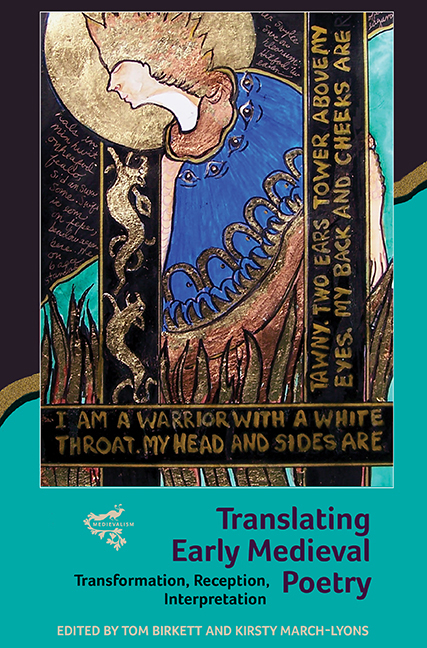Book contents
- Frontmatter
- Contents
- Acknowledgements
- Contributors
- Introduction: From Eald to New
- 1 From Eald Old to New Old: Translating Old English Poetry in(to) the Twenty-first Century
- 2 Edwin Morgan's Translations of Anglo-Saxon Poetry: Turning Eald into New in English and Scots
- 3 Gains and Losses in Translating Old English Poetry into Modern English and Russian
- 4 Borges, Old English Poetry and Translation Studies
- 5 ‘Let Beowulf now be a book from Ireland’: What Would Henryson or Tolkien Say?
- 6 The Forms and Functions of Medieval Irish Poetry and the Limitations of Modern Aesthetics
- 7 Aislinge Meic Conglinne: Challenges for Translator and Audience
- 8 Translating Find and the Phantoms into Modern Irish
- 9 Reawakening Angantýr: English Translations of an Old Norse Poem from the Eighteenth Century to the Twenty-first
- 10 Translating and Retranslating the Poetic Edda
- 11 From Heroic Lay to Victorian Novel: Old Norse Poetry about Brynhildr and Thomas Hardy's The Return of the Native
- 12 Michael Hirst's Vikings and Old Norse Poetry
- Afterword
- A Translation of Riddle 15 from the Exeter Book
- Bibliography
- Index
- Miscellaneous Endmatter
12 - Michael Hirst's Vikings and Old Norse Poetry
Published online by Cambridge University Press: 01 September 2018
- Frontmatter
- Contents
- Acknowledgements
- Contributors
- Introduction: From Eald to New
- 1 From Eald Old to New Old: Translating Old English Poetry in(to) the Twenty-first Century
- 2 Edwin Morgan's Translations of Anglo-Saxon Poetry: Turning Eald into New in English and Scots
- 3 Gains and Losses in Translating Old English Poetry into Modern English and Russian
- 4 Borges, Old English Poetry and Translation Studies
- 5 ‘Let Beowulf now be a book from Ireland’: What Would Henryson or Tolkien Say?
- 6 The Forms and Functions of Medieval Irish Poetry and the Limitations of Modern Aesthetics
- 7 Aislinge Meic Conglinne: Challenges for Translator and Audience
- 8 Translating Find and the Phantoms into Modern Irish
- 9 Reawakening Angantýr: English Translations of an Old Norse Poem from the Eighteenth Century to the Twenty-first
- 10 Translating and Retranslating the Poetic Edda
- 11 From Heroic Lay to Victorian Novel: Old Norse Poetry about Brynhildr and Thomas Hardy's The Return of the Native
- 12 Michael Hirst's Vikings and Old Norse Poetry
- Afterword
- A Translation of Riddle 15 from the Exeter Book
- Bibliography
- Index
- Miscellaneous Endmatter
Summary
FROM THEIR VERY beginnings, Old Norse myth and poetry have been worked and reworked, written and rewritten, interpreted and reinterpreted, across a range of media. Various runestones, particularly from Sweden, depict scenes from myth and legend which are also recounted in the Poetic Edda. The eddic poetry of the Volsung cycle, to take one example among many, is found preserved – partially – within Vǫlsunga saga. Here, not only do a number of stanzas cited in the saga come from eddic poems but also Vǫlsunga saga itself is largely a prose retelling of the eddic Volsung sources. Slightly later in Icelandic literary history rimur (long stanzaic narrative poems) emerge as a literary form. Three cycles of rimur – Vǫlsungs rimur, Trymlur and Lokrur – find their inspiration in eddic and heroic sources. Furthermore, the development of the rimur form itself was at least partially influenced – in terms of ‘style, diction, and metrics’ – by the conventions of both eddic and skaldic poetry. A range of English poetry – from the medieval to the modern – shows the clear influence of Old Norse sources. O'Donoghue's study of The Return of the Native in this volume makes clear the influence of Old Norse poetry on one particular English author, and a number of novels, ranging from the high fantasy of J. R. R. Tolkien to the young adult fiction of Melvin Burgess, also owe a great debt to medieval Norse material. Comics and graphic novels, too, have drawn on material from Norse myth and legend. Norse material has also inspired a range of musical works, ranging from Richard Wagner's operatic Ring cycle to viking metal. Literal translation has kept Old Norse poetry alive, in myriad languages, for hundreds of years. But translation – whether literal, cultural or both – is not limited to the plastic, the graphic, the musical or the textual. The twentieth and twenty-first centuries have given rise to a number of cinematic works that are either inspired by Norse material or can be regarded as adaptations of it.
- Type
- Chapter
- Information
- Translating Early Medieval PoetryTransformation, Reception, Interpretation, pp. 199 - 212Publisher: Boydell & BrewerPrint publication year: 2017

